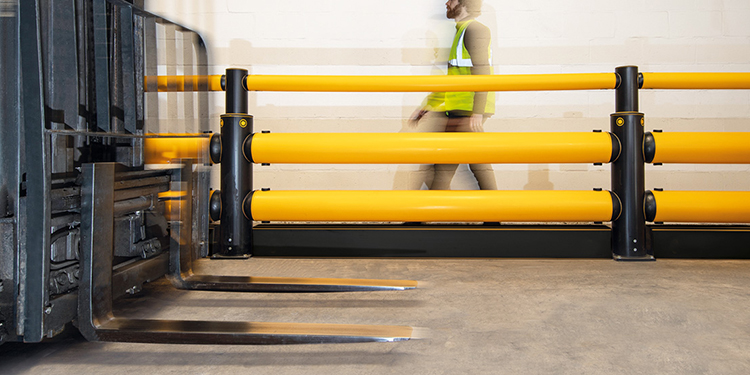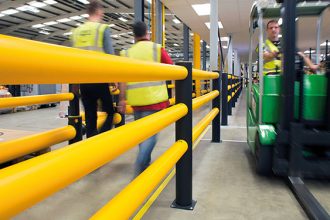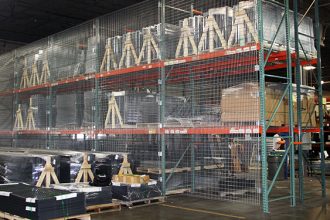Prevent Damage From Lift Trucks With Protective Curb Barriers

When traveling throughout a facility, lift truck operators typically raise the loaded (or unloaded) forks of their vehicles 3 to 4 inches above the floor. This prevents the tips of the forks from grinding against the floor surface — usually concrete — and wearing down to a dangerously sharp edge. It also ensures the operator has a better view of the travel path.
However, even with an unobstructed view, a risk still exists for empty forks or those that extend beyond the load to accidentally strike building structures or assets, such as equipment, machinery, workstations, pallet rack uprights, conveyor supports, walls, columns, or mezzanine pillars. Even areas already shielded by protective barriers and guardrails are susceptible, as low-riding forks might pass underneath them. This means “protected” walkways or pedestrian zones have gaps that still pose a risk to pedestrians, machinery and structures.
To protect against such incidents and prevent damage from lift truck forks, protective curb barriers measuring up to 8 inches tall can be installed at ground level. Also referred to as ground level barriers and floor level barriers, these protective curbs are typically made of either polymer materials or steel. For maximum impact resistance, the barriers are anchored securely to the floor with specialized bolts.
Should an impact occur, the curbs disperse the force in one of two ways — depending on the material from which they are made. Steel will resist an impact but will also be deformed permanently. Any energy not absorbed by the deformation is transferred to the anchors and the floor. Depending on the force of the impact, the anchors may become unseated, knocking the steel curb out of position. Conversely, curbs made of polymer are designed to absorb and dissipate impact energy by flexing and then returning to their original shape. If they are struck by an extremely sharp fork tip, however, they may be pierced.
Protective curbs can either be installed at the same time as a new guardrail solution, or they can be added later as a retrofit to an existing installation. For maximum visibility, they are usually colored safety yellow — either with paint on steel systems or self-colored for polymer barriers.
In addition to protecting sensitive equipment and personnel, curbs can also be installed for use as a pallet stop. When the forks (or load) make contact with the barrier at a slow, controlled rate of approach, the operator can physically detect the proper position of a pallet load and adjust to compensate as necessary prior to lowering it. These types of installations are most often found in applications where the pallet must be precisely positioned without impacting a wall or machine.
Want more details about installing protective curbs and other barriers in your facility? The members of the Protective Guarding Manufacturers Association (ProGMA) are available for guidance and recommendations.



